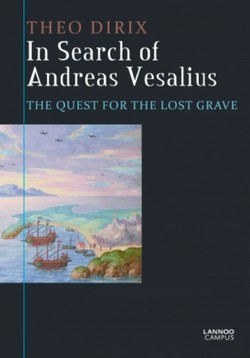
Cover of the book by Theo Dirix
We are getting closer and closer to the objective, that is, to fund and find the lost grave of Andreas Vesalius, recognized worldwide as the Father of Modern Anatomy. We are setting up the dates for the next phase and preparing the logistics for the crews from Crete and Belgium.
The quest for the lost grave of Andreas Vesalius continues, the permits have been obtained, and we only have the last hurdle to finish, the funding of the project trough our GoFundMe page.
Theo Dirix, a contributor to Medical Terminology Daily, now has an offer that you may like. He wrote the book "In Search of Andreas Vesalius" which relates the beginning of this Quest. The book is out-of-print today, but there are a few copies available. By donating 30 € (US$35)you'll receive one of the last available copies and you'll be mentioned in the sequel of the book that will be dedicated to the next stage of the project.
The project is private and funded by those who believe we still have an opportunity to find the lost grave. For more information, you are welcome to read Theo Dirix's article : "To put it in another way: where do we have to look for Vesalius's grave?"
Here are some reviews for Theo Drix's book "In Search of Andreas Vesalius" :
Vivian Nutton: "I read with pleasure and wry amusement Theo’s account (..) and was reminded of reading the autobiographical account by Stephen Miller of his time as head of the American archaeological school and the boss of the Nemea excavations in the 1980s and 90s (...)
(Professor Vivian Nutton specialises in the history of the classical tradition in medicine, from Antiquity to the present, and particularly on Galen, some of whose works he has edited and translated, and on medicine during the Renaissance.)
Jacqueline Vons: " here is a book " without claim " but well documented, which is committed to tracing the research made to zakynthos by the author and a team of doctors, historians and artists to find the tomb of vesalius (1514-1564).
(Jacqueline Vons est professeur agrégé de lettres classiques, docteur ès études latines, enseignant-chercheur habilité à diriger des recherches. Elle a enseigné le latin et l'histoire de la médecine au CESR et à la faculté de Lettres de Tours et a assuré pendant plusieurs années des enseignements complémentaires en sciences humaines à la faculté de Médecine. Ses thèmes de recherche sont orientés vers l'histoire de la médecine et notamment autour d'André Vésale (éditions, traductions, transcriptions), de la pensée et des pratiques médicales en France à l'époque moderne ainsi que des textes médicaux latins centrés principalement sur l'anatomie.)
Maurits Biesbrouck: in search of Andreas Vesalius is so well researched and written, that if the further search for his grave completely shutting down (something we hope not! ) and only after a few decades be rebooted again, the perfect future researchers would know to where you came, and the wire without wasting time we can again. It is a very detailed history of the search that has already been made, a solid status and simultaneously present an extremely valuable tool for further extrapolating.
(Dr. Maurits Biesbrouck has a lifelong interest in Andreas Vesalius. He translated the first book of the De Humani Corporis Fabrica Libri Septem into Dutch, compiled an annually updated Vesalius-bibliography and wrote many articles on his life and works, many as a co-author with Omer Steeno (Leuven, Belgium) and Theodoor Goddeeris (Kortrijk, Belgium). See www.andreasvesalius.be.)
UPDATE: April 25, 2018. Theo Dirix's new book is already published, the names of the contributors have been incorporated in the book. The title of the new book is "In Search of Andreas Vesalius The Quest for the Grave, Lost and not yet found". Dr. Miranda



